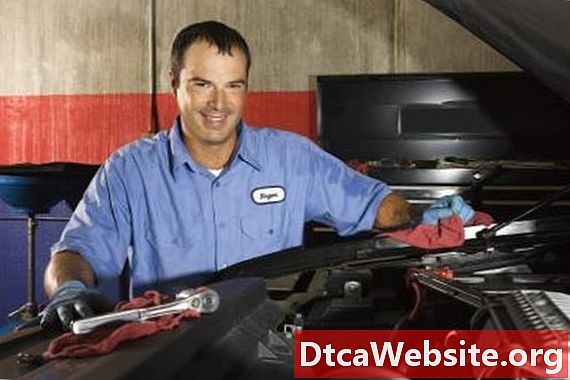
Contenu

To assist a cars driver in turning the steering wheel with ease, a power steering pump transfers power steering fluid under high pressure to a cars steering box. A cracked or leaking power steering reservoir can lead to a prematurely worn or malfunctioning power steering pump and should be replaced immediately to ensure the continued safe operation of the power steering system. Replacing the power steering reservoir can be accomplished by the do-it-yourself vehicle owner with moderate mechanical abilities.
Step 1
Place the vehicle in park or neutral with the emergency brake set. Raise the hood and disconnect the negative battery cable with an end wrench. Refer to your owners manual to locate the power steering pump and the belt tensioner for the serpentine belt. Place a socket and wrench over the large nut on the belt tensioner and twist the wrench to unload the belt pressure. Slip the belt off the power steering pump pulley. Remember the routing configuration of the serpentine belt, or refer to the diagram in your repair manual.
Step 2
Place a drip pan underneath the power steering pump to catch drippings. Use a fuel line wrench to loosen the metallic nut that holds the high-pressure fluid line to the pump body. Pull the metallic line away from the pump body. Use a slot screwdriver to loosen the hose clamp on the low-pressure (rubber) fluid line that leads into the pump body. Pull both lines away for access to the pump.
Step 3
Use the correct size socket on the end of an extension to remove the three bolts that hold the pump body to the block. Some power steering pumps have holes in their pulleys. If this is the case, rotate the pulley and stick the extension and socket through the pulley holes. Turn the bolts counterclockwise to remove them. Pull the power steering pump free from the engine compartment.
Step 4
Locate the two metal snap flanges on each side of the reservoir. Use a slot screwdriver to pry them apart and pull the reservoir out of the pump body. The reservoir will have a large tube nipple that slips out of the pump body. Be sure to keep the O-ring inside the pump. Wipe off the mating surface between the pump and reservoir with a rag.
Step 5
Push the new reservoir into the pump body, making sure the large nipple seats inside the grommet. Use a slot screwdriver to snap the retaining clips back in place. Align the power steering pump with its mating surface against the block, and run the bolts in on the end of the extension by hand. Tighten the bolts with the ratchet wrench.
Step 6
Screw the high pressure fluid line into the pump body by hand. Tighten it with the fuel line wrench. Reconnect the low-pressure rubber hose to the nipple and tighten the hose clamp with a slot screwdriver. Use a socket and wrench to turn the large bolt on the belt tensioner, loading it with pressure. While holding pressure on the belt tensioner, slip the serpentine belt back onto the power steering pump pulley. Release the belt tensioner pressure with the ratchet wrench.
Remove the cap on the new reservoir and fill it to the top with the manufacturers recommended power steering fluid. Wipe away any drippings on the pulley or belt. Reconnect the negative battery cable with an end wrench. Start the engine and check the power steering pump for proper operation.
Tip
- For power steering pumps that must be accessed and removed from the bottom, lift the vehicle with a floor jack and place two jack stands under the front part of the frame near each wheel. Remove the pump, as the instructions dictate.
Items you will need
- Owners repair manual
- Floor jack (if applicable)
- Jack stands (if applicable)
- Screwdrivers
- Socket set
- Socket extension
- Ratchet wrench
- End wrenches
- Fuel line wrenches
- Drain pan
- Power steering pump reservoir
- Rags


